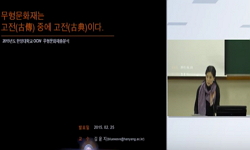‘땅설법’은 불교의례를 하고 난 뒤 좀 더 편안한 분위기에서 참여한 신도들을 상대로 뒤풀이 성격의 장이라 일컬어졌다. 그러나 앞서 알려진 ‘삼회향놀이’와 혼동되었다. 그것은 땅설...
http://chineseinput.net/에서 pinyin(병음)방식으로 중국어를 변환할 수 있습니다.
변환된 중국어를 복사하여 사용하시면 됩니다.
- 中文 을 입력하시려면 zhongwen을 입력하시고 space를누르시면됩니다.
- 北京 을 입력하시려면 beijing을 입력하시고 space를 누르시면 됩니다.
https://www.riss.kr/link?id=A106357505
- 저자
- 발행기관
- 학술지명
- 권호사항
-
발행연도
2019
-
작성언어
Korean
-
주제어
땅설법 ; 다여 ; 전승 ; 강ㆍ창ㆍ연 ; 6마당 ; 화엄성중신앙 ; 불교민속 ; 무형 문화 ; 대중교화 ; 불교문화. ; Ttangsŏlbŏp ; Tayŏ(茶如) ; instructionaloration(講) ; pansorisinging(唱) ; performance(演) ; six chapters ; Hwaŏmsŏngjung(華嚴聖衆) belief ; Buddhist Folk ; magnificent intangible cultural asset ; edification of the public ; Buddhist culture.
-
KDC
220.1
-
등재정보
KCI등재
-
자료형태
학술저널
- 발행기관 URL
-
수록면
173-203(31쪽)
- DOI식별코드
- 제공처
- 소장기관
-
0
상세조회 -
0
다운로드
부가정보
국문 초록 (Abstract)
‘땅설법’은 불교의례를 하고 난 뒤 좀 더 편안한 분위기에서 참여한 신도들을 상대로 뒤풀이 성격의 장이라 일컬어졌다. 그러나 앞서 알려진 ‘삼회향놀이’와 혼동되었다. 그것은 땅설법의 전승이 단절된 것으로 알려졌고 그에 따라 그 실체를 알 수 없었기 때문이다. 그러나 최근에 ‘땅설법’이 강원도 삼척 안정사(安政寺) 다여(茶如)스님에 의해 전승되어 왔음이 알려졌다. 이러한 땅설법은 6마당(석가모니일대기, 선재동자구법기, 목련존자일대기, 만석승일대기, 성주신일대기, 신중신일대기)으로 이루어져 있다. 본고에서는 그동안 2차에 걸쳐 시연된 석가모니일대기, 성주신일대기, 신중신일대기 등 3마당을 근거로 하여 그 성격을 규명하고자 하였다. 설행된 3마당은 강(講)․창(唱)․연(演)이 어우러진 구조를 보여주었고, 그 사상적 기반이 전래의 화엄경(華嚴經)과 화엄성중신앙(華嚴聖衆信仰)임을 알게 하였다. 거기에는 민속적인 부분들이 많이 수용되고 있으나 반드시 법문을 빠뜨리지 않고 있다. 즉 땅설법은 불교적 교화의 방편을 잘 보여준 것이었다. 이것은 땅설법의 근본 목적이 대중교화를 위한 것이므로 다양한 민속을 받아들여 일반 대중이 쉽게 다가갈 수 있는 내용인 것이다. 본 연구를 통해 땅설법이 한문이 아닌 우리말로 민속적인 성격을 가미하여 펼쳐진 장으로, 뒤풀이 성격이 아닌 어느 때, 어떤 법회에서나 그 법회의 성격에 맞춰 변용이 가능한 원융무애(圓融無碍)가 펼쳐질 수 있는 독립된 양식임을 확인하였다. 앞으로의 과제는 땅설법의 원형 발굴과 그 사설이 모두 기록되어야 할 것이며, 또한 나머지 땅설법 시연이 베풀어지고 좀 더 폭넓은 연구가 이루어져야 할 것이다. 이러한 연구가 땅설법이 새로운 대중교화 및 불교문화로, 나아가서는 불교축제로까지 지평을 넓힐 수 있는 계기가 될 것이라 생각한다.
다국어 초록 (Multilingual Abstract)
Ttangsŏlbŏp refers to the transmission of Buddhist teachings to the public in a relaxed atmosphere after the completion of Buddhist rituals. Ttangsŏlbŏp incorporates elements of folk culture and is carried out using the Korean language devoid of...
Ttangsŏlbŏp refers to the transmission of Buddhist teachings to the public in a relaxed atmosphere after the completion of Buddhist rituals. Ttangsŏlbŏp incorporates elements of folk culture and is carried out using the Korean language devoid of classical Chinese characters. However, it has been impossible to know the true nature of Ttangsŏlbŏp, and it was believed the practice itself had ceased entirely. However, recently Korean Buddhist monk Tayŏ(茶如) has again begun the transmission of Ttangsŏlbŏp at Anjeongsa(安政寺) Temple in Samcheog, Gangwon Province. Ttangsŏlbŏp is composed of six chapters: the story of Sakyamuni, Sudhana’s seeking of the dharma, the story of Maudgalyayana, the story of Monk Manseok, the story of the Sŏngju Spirit, and the story of the Shinjung Spirit. So far, three chapters—the story of Sakyamuni, the story of the Sŏngju Spirit, and the story of the Shinjung Spirit—have been performed over the course of two public performances. Inthisessay I wil lattempt to define the nature of Ttangsŏlbŏp on the basis of these three chapters. These three chapters display astructure which combines instructionaloration(講), pansori singing(唱) and performance(演). Moreover, its philosophical foundation comes from the Avatamska Sutra and Hwaŏmsŏngjung(華嚴聖衆) belief. Although Ttangsŏlbŏp incorporates many folk elements, it is not devoid of Buddhist teachings. Indeed, Ttangsŏlbŏp offers a useful tool for the edification of the unenlightened. Ttangsŏlbŏp’s primary objective is the conversion of the public and therefore accepts folk culture as an expedient for easily communicating with the public. This paper shows that Ttangsŏlbŏp is not simply an amusing performance, but can conform to the needs of any particular Buddhist assembly for worship and is an appropriate form for experiencing reality as a harmonies, and uninterrupted whole. Going forward, the original form of Ttangsŏlbŏp must be unearthed and recorded. Additionally, the remaining three chapters of Ttangsŏlbŏp should be performed and researched in depth. In doing so, Ttangsŏlbŏp could become the next magnificent intangible cultural asset of South Korea. I also look forward to Ttangsŏlbŏp being able to expand the horizons of Buddhist edification of the public, Buddhist culture, and Buddhist festivals.
목차 (Table of Contents)
- 한글요약
- Ⅰ. 머리말
- Ⅱ. 땅설법 설행의 실재
- 1. 화엄성주대재 설행에서 보여준 땅설법
- 2. 신중신일대기 설행에서 보여준 땅설법
- 한글요약
- Ⅰ. 머리말
- Ⅱ. 땅설법 설행의 실재
- 1. 화엄성주대재 설행에서 보여준 땅설법
- 2. 신중신일대기 설행에서 보여준 땅설법
- Ⅲ. 땅설법과 화엄성중신앙
- Ⅳ. 맺음말
- 참고문헌
- Abstract
동일학술지(권/호) 다른 논문
-
- 한국정토학회
- 최동순
- 2019
- KCI등재
-
가재의 『정토론』에 드러난 왕생요인(要因)과 왕생인(人)
- 한국정토학회
- 정관균(법상)
- 2019
- KCI등재
-
- 한국정토학회
- 이민경(탄호)
- 2019
- KCI등재
-
華嚴學과 易學을 통해 본 呑虛의 艮山思想 - 오대산과 계룡산의 의미망을 중심으로 -
- 한국정토학회
- 권기완(문광)
- 2019
- KCI등재





 KCI
KCI eArticle
eArticle







